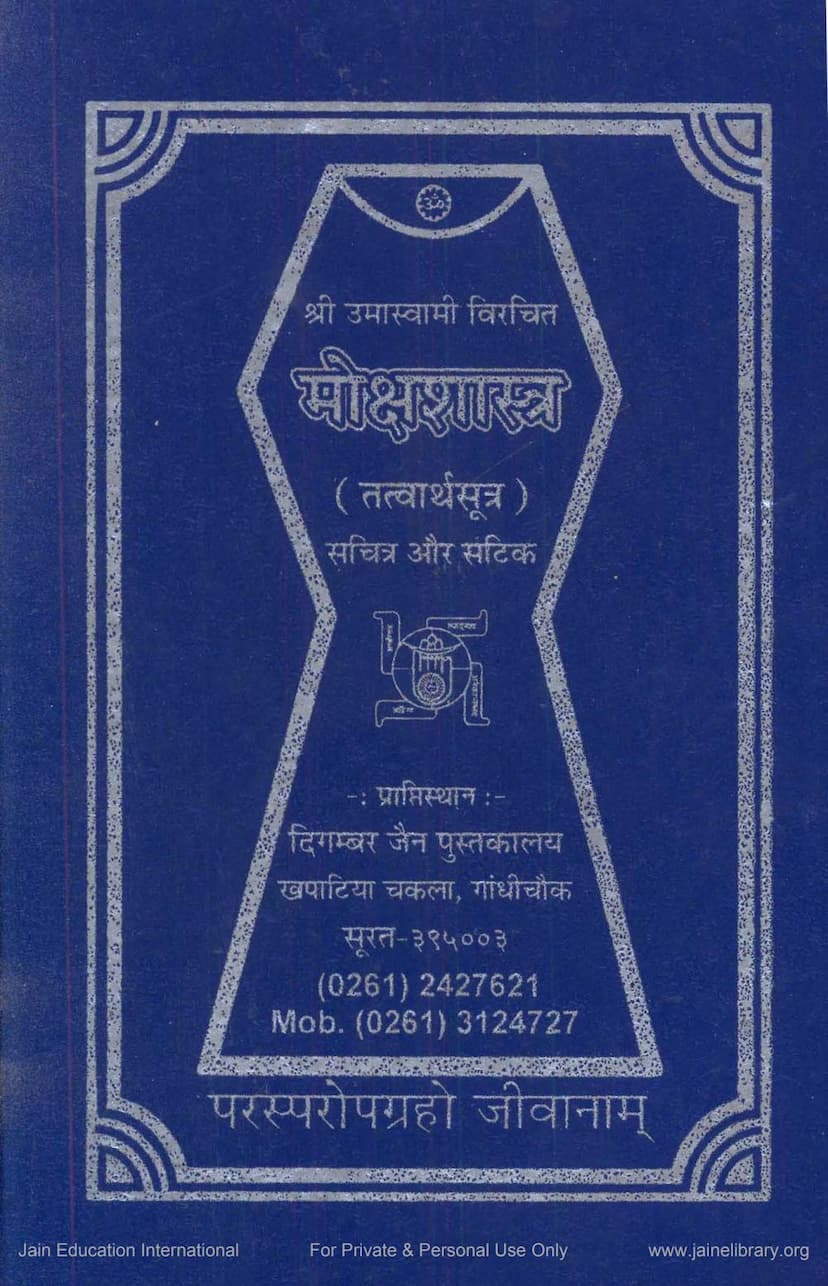Mokshshastra
Added to library: September 2, 2025

Summary
Here is a comprehensive summary of the Jain text "Mokshashastra (Tattvarthasutra)" by Acharya Umaswati, based on the provided information:
Book Title: Mokshashastra (also known as Tattvarthasutra) Author: Acharya Umaswati (also referred to as Umaswami) Commentary/Edition: Edited and annotated by Pandit Pannalal Jain 'Vasant' and includes 56 question-answers by Pandit Phoolchandji Siddhantashastri. Publisher: Digambar Jain Pustakalay, Surat.
Overall Significance: Mokshashastra (Tattvarthasutra) is a foundational and highly revered text in Jainism, considered by many to be the "Bible" of Jain philosophy. It is notable for being the first major Jain work written in Sanskrit, bridging the gap from earlier Prakrit scriptures. The text is universally accepted by both the Digambara and Shvetambara traditions of Jainism. Its central theme is the path to liberation (moksha).
Core Teachings and Structure: The book's primary purpose is to illuminate the true path to liberation for all beings trapped in the cycle of birth and death. The central tenet, stated in the first sutra, is "Samaygdarshan-gyan-charitrani Mokshamargah" (Right Faith, Right Knowledge, and Right Conduct together constitute the path to liberation). This trinity is the essence of the Moksha Marg.
The text is structured into ten chapters, each delving into specific aspects of Jain philosophy and practice:
- Chapter 1 (Tattvartha-shradhan): Focuses on Right Faith (Samya gdarshan) and Right Knowledge (Samya gyan), defining their nature, types, and the means to attain them. It introduces the concept of Nicheps (modes of speaking) and Pramana-Naya (means of valid cognition).
- Chapter 2 (Jiva-tattva): Explores the essence of the Soul (Jiva). It details the soul's inherent attributes, states (Bhavas - Aupashamik, Kshāyik, Kshāyopshamik, Audayik, Pārināmik), senses, modes of existence, birth types, and the different types of bodies (sharira).
- Chapter 3 (Loka-Prapana): Describes the structure of the universe (Loka), detailing the lower worlds (Narakaloka) and the middle world (Madhyaloka), including their inhabitants and environments.
- Chapter 4 (Deva-tattva): Discusses the celestial beings (Devas), categorizing them into four classes: Bhavanvāsī (dwelling in residences), Vyantar (intermediate beings), Jyotishka (celestial lights), and Vaimānika (those residing in flying vehicles). It outlines their abodes, characteristics, and lifespans.
- Chapter 5 (Ajiva-tattva): Explains the non-living realities (Ajiva), which include Dharma (principle of motion), Adharma (principle of rest), Akash (space), Pudgala (matter), and Kala (time). It details their inherent qualities, pervasiveness, and interactions.
- Chapter 6 (Āsrava): Focuses on the influx of karma (Asrava), which binds the soul. It explains the causes of Asrava, primarily through Yoga (activity of mind, speech, and body) driven by passions (Kashaya). It details how different passions and activities lead to the influx of specific types of karma (Punya and Pap).
- Chapter 7 (Samvara): Deals with the cessation of karma influx (Samvara). This is achieved through the practice of restraining passions and activities. It elaborates on the importance of Guptis (control of mind, speech, body), Samitis (careful conduct), ten virtues (Dharma), twelve contemplations (Anupreksha), conquering afflictions (Parishaha), and Right Conduct (Charitra). It also details the vows and ethical observances for lay followers (Shravaka).
- Chapter 8 (Bandha): Explains the bondage of karma (Bandha). It elaborates on the nature of karma, its eight main types (Jnanavaraniya, Darshanavaraniya, Vedaniya, Mohaniya, Ayuh, Nama, Gotra, Antaraya), and the specific causes leading to their bondage in terms of their eightfold subdivisions (Prakriti, Sthiti, Anubhaga, Pradesha).
- Chapter 9 (Samvara & Nirjara): Discusses the principles of Samvara (cessation of karma influx) and Nirjara (shedding of accumulated karma). It reiterates the importance of austerities (Tapa) as the primary means for Nirjara, detailing both external and internal austerities and their subdivisions. It also categorizes spiritual practices like Guptis, Samitis, Virtues, and Meditations (Dhyana) that lead to Samvara and Nirjara.
- Chapter 10 (Moksha): Describes the state of liberation (Moksha). It explains that Moksha is achieved by the complete annihilation of all karma, particularly the four destructive karmas (Ghatiya), leading to the manifestation of the soul's inherent pure qualities like infinite knowledge, perception, bliss, and energy. It describes the soul's upward journey after liberation and the reasons for its final abode in the siddhashila (abode of the liberated).
Key Features of the Presented Edition:
- Commentary: The edition features a detailed and simplified commentary by Pandit Pannalal Jain 'Vasant', making the profound teachings accessible to a wider audience.
- Q&A: Includes 56 question-answers compiled by Pandit Phoolchandji Siddhantashastri, which are particularly helpful for students and those engaged in self-study.
- Illustrations: The text is enriched with pictures, maps, and charts to aid understanding.
- Structured Presentation: Includes a table of contents, glossaries (Lakshan Sangrah), and other aids for study.
- Educational Focus: The edition is designed to be student-friendly, aiming to facilitate a deep comprehension of Tattvarthasutra, ensuring clarity and preventing failure for diligent students.
- Multiple Editions: The fact that this is the eleventh edition indicates its sustained popularity and utility within the Jain community.
Author's Context (Umaswati): Acharya Umaswati is a highly respected figure in Jainism. While details of his life are not entirely clear, he is recognized by both major Jain sects. He is credited with initiating the use of Sanskrit for Jain philosophical works, paving the way for subsequent scholars. The text mentions an interesting account of how Umaswati encountered a scholar who had penned a verse, and Umaswati added the crucial word "Samyak" (Right), thereby defining the path to liberation. This anecdote highlights the tradition of collaborative scholarship and the profound impact of precise philosophical definitions.
In essence, Mokshashastra is a comprehensive and systematic exposition of Jain philosophy, covering cosmology, ontology, ethics, and the path to ultimate liberation, making it an indispensable text for understanding the core principles of Jainism.